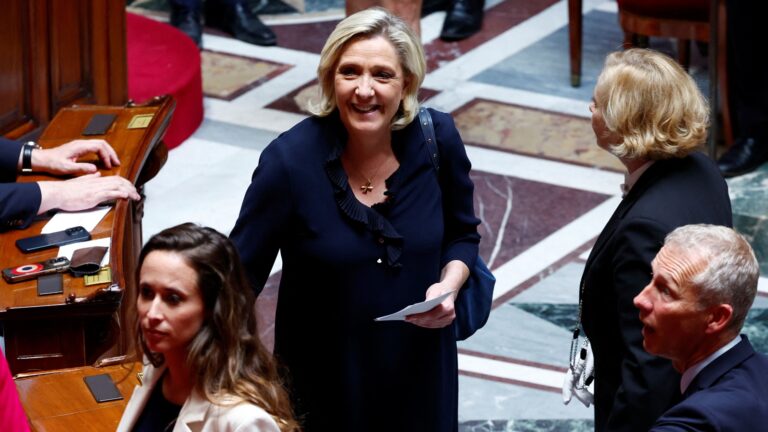When French President Emmanuel Macron recently called for early elections, he was labeled an arsonist firefighter because, without constitutional, common sense or necessity, he threw the country into a conflagration that could only have one obvious outcome: an unprecedented victory for the French far right. No one knows what Macron was thinking, but his decision was likely triggered by his frustration over a series of no-confidence motions against his prime minister, who lacked the necessary majority in the National Assembly to pass legislation. He probably thought that at best the elections would produce some kind of clear majority, and at worst, the conflagration would burn and teach at least a lesson or two to his main troublemakers, the far left and the far right.
now The election is overFrance Agnipariksha France is as messy now as it was before. The great French humorist Coluche once said: “If voting could change things, it would have been banned a long time ago.” Rather than a majority, several minorities have now emerged, all of which are below the 289 seats required for a majority of 577 seats. The left-wing New Popular Front (comprised of Insubordinate France, the Socialists and the Economists) leads with 182 seats, followed by Macron’s centre-right group Ensemble (168 seats) and Marine Le Pen’s far-right party National Rally and its alliances (143 seats). But it is important to understand how the left and centre-right managed to reach these somewhat respectable figures in the first place, when the far-right was widely expected to win a majority. Faced with the inevitability of a National Rally victory in France, which was seen as a threat to France’s constitutional rule itself, the Left Front and the centre-right reached a republican, or democratic, agreement to vote for each other. So in the runoff election, the left voted for the center-right and the center-right voted for the left, working together to prevent a xenophobic, racist far-right party from taking power.
But the irony is that the harsh truth revealed by this election is that their losers are actually the only winners: the National Rally and its allies. With 143 members in the National Assembly, the National Rally is the single largest party in the country. This is the first time this has happened. In two years, its number has soared from 85 to 143 members, a level that is comparable to its performance earlier this century, and it has risen to this level from practically nonexistence in the National Assembly. In the recent election, in 25% of the total number of French electoral districts, the party’s candidates won more than 40% of the vote before succumbing to a counterattack by the left-center-right Republicans. Looking at a map of the recent French elections, it resembles an aerial photograph of monsoon floods in India, with cities large and small (in this case Paris, Lyon, Lille, etc.) looking like islands in a sea of far-right dominated areas.
That is certainly true. National Meeting.
When Marine Le Pen became leader of the National Front in 2011, she found that her father Jean-Marie Le Pen’s outrageously racist, vulgar and rebellious public behaviour had led to the demonisation of the party. The National Front was widely hated and despised; in televised debates, its spokesmen were more or less laughed at by viewers. Marine Le Pen then stepped in, arguing that what the party urgently needed was legitimacy, respect and mainstreaming, and that to achieve this, it was necessary to slowly, step by step, reshape the party’s political and ideological thinking in a new direction.

Marine Le Pen She began by distancing herself from her father’s radical far-right bashing. Jean-Marie Le Pen was expelled from the party, giving his daughter free reign to run it. She replaced her father’s macho demeanor with a firm, yet soft-spoken, feminine presence. Initially, she did not appear to have a clear blueprint for the party, but she skillfully used her personal judgment and intuition to bring about change, learning from her experiences on the battlefield.
She changed the name of the party. The Rassemblement National (literally, the National Gathering) replaced the demonized National Front. She welcomed new, younger cadres into the party, good-looking young men and women who were not from the masses or working class that had been the old National Front’s traditional “base.” Spurred by the anger caused by Islamic-backed terrorist attacks in France and a new wave of immigration from the Middle East, she expanded her reach outside the traditional far-right strongholds, into areas where anger, frustration, despair and economic hardship were rampant and people were looking for a friendly listener. The National Rally’s spectacular performance in recent elections and Marine Le Pen’s 13 million votes in the 2022 presidential election are the direct result of these skillful reorganizations and “healing” moves.

France is still in turmoil. The parties of the Left Front are fighting to agree on a candidate for prime minister, while Macron is trying to find an alternative from the center and the republican right. But whoever takes power will have to face the horrifying reality that almost 40% of the country, who grew up with the slogans of liberty, equality and fraternity, voted for the xenophobic, racist and anti-Semitic National Rally. The new government and President Macron must regain the trust of at least half of the National Rally’s newly formed support base, which is nothing more than young people tossed about by the rough seas of a protracted socio-economic crisis. Far from practicing sectarian “untouchability” against these vagabonds among the National Rally voters, the new government must invite them back into the republican system, especially from the left. Gal VapsiIf so, the outcome is clear: the far-right will soon be knocking on the doors of the Elysée Palace.
Singh is a writer and film director.
© Indian Express Ltd.
First uploaded: 20 July 2024 16:17 IST


